|
Printables |
PowerPoints |
Online exercises |
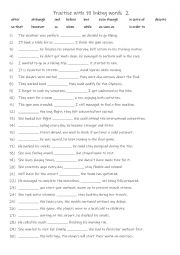
|
A2+-B1 Practise with 15 Linking words 2
Students should learn these linking words because they are essential for creating complex, logical sentences that convey relationships such as contrast (although, however), cause and effect (so that, in order to), and time (before, as soon as). Mastering them enhances writing and speaking by making language more sophisticated and engaging, as stude...
Level: intermediate
Age: 10-100
Type:
Downloads: 111
|
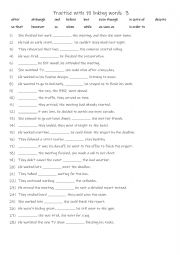
|
A2+-B1 Practise with 15 linking words 3
First, students need to familiarise themselves with the 15 linking words and their usage. Then they read the sentences to see which one is needed to complete the sentences in a natural way. Each linker is used 2 times! Answers on page 2
Level: elementary
Age: 8-100
Type:
Downloads: 109
|
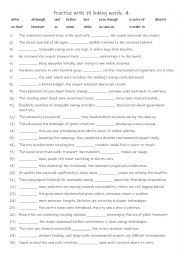
|
A2+-B1 Practise with 15 linking words 4
First, students need to familiarise themselves with the 15 linking words and their usage. Then they read the sentences to see which one is needed to complete the sentences in a natural way. Each linker is used 2 times! Answers on page 2
Level: elementary
Age: 10-100
Type:
Downloads: 100
|
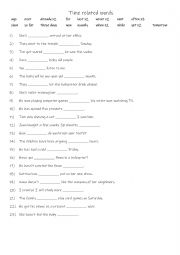
|
A2+-B1 Practise with 17 adverbs of time 2
First, students need to familiarise themselves with the 17 time expressions and their use. Then they read the sentences to work out which one is needed to complete the gap-fill. Answers on page 2
Level: intermediate
Age: 9-100
Type:
Downloads: 107
|
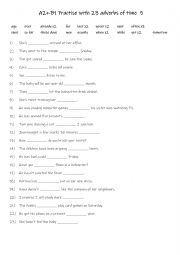
|
A2+-B1 Practise with 17 adverbs of time 5
Recognising these expressions improves listening and reading comprehension, enabling students to grasp stories, instructions, and conversations more effectively. First, students need to familiarise themselves with the 17 time expressions and their use. Then they read the sentences to work out which one is needed to complete the gap-fill. Answers on...
Level: elementary
Age: 9-100
Type:
Downloads: 113
|
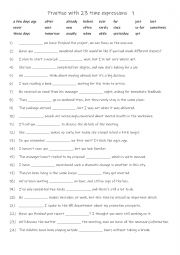
|
A2+-B1 Practise with 23 adverbs of time 1
Students should learn these time expressions because they are essential for clear and precise communication, allowing them to express when events occur in speech and writing. They play a crucial role in mastering grammar, particularly in using tenses accurately, such as employing "since" with the present perfect or "yesterday" with the past simple....
Level: elementary
Age: 9-100
Type: worksheet
Downloads: 120
|
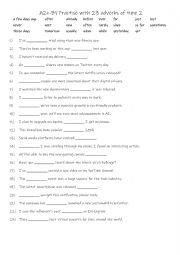
|
A2+-B1 Practise with 23 adverbs of time 2
First, students need to familiarise themselves with the 23 time expressions and their use. Then they read the sentences to work out which one is needed to complete the gap-fill. Answers on page 2
Level: elementary
Age: 10-100
Type:
Downloads: 104
|
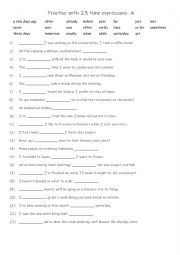
|
A2+-B1 Practise with 23 adverbs of time 4
Recognising these expressions improves listening and reading comprehension, enabling students to grasp stories, instructions, and conversations more effectively. First, students need to familiarise themselves with the 23 time expressions and their use. Then they read the sentences to work out which one is needed to complete the gap-fill. Answers on...
Level: elementary
Age: 10-100
Type:
Downloads: 112
|
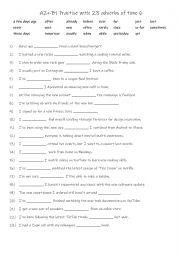
|
A2+-B1 Practise with 23 adverbs of time 6
Recognising these expressions improves listening and reading comprehension, enabling students to grasp stories, instructions, and conversations more effectively. First, students need to familiarise themselves with the 23 time expressions and their use. Then they read the sentences to work out which one is needed to complete the gap-fill. Answers on...
Level: elementary
Age: 11-100
Type:
Downloads: 119
|
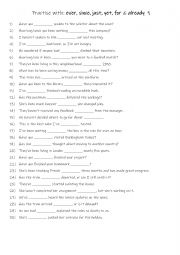
|
A2+-B1 Practise with ever, since, just, yet, for & already 1
Students should learn ever, since, just, yet, for, and already because they are essential for expressing time relationships and mastering perfect tenses. These words allow students to ask about experiences (ever), specify starting points (since), describe recent actions (just), highlight incomplete tasks or questions (yet), express durations (for),...
Level: intermediate
Age: 9-100
Type:
Downloads: 121
|
|
|
|
|












